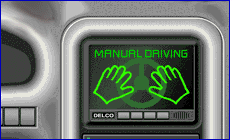
Cars driving on automated highways will be guided under lateral (steering) and longitudinal (speed and spacing) control: Images courtesy of Monolith interactive Solutions.

Upon approaching a destination in an automated highway system, a signal is emitted advising the driver to resume manual control.

The Navlab 5, a 1990 Pontiac Trans Sport. Image courtesy of the Navlab Project at Carnegie Mellon University.


Robot cars: Coming not-so-soon to a highway near you
As Sojourner (the Mars rover) showed, driving by computer is not too difficult, when you don't have to worry about traffic -- or staying on the (non-existent) pavement. But what are the prospects for setting a robot car loose on real highways. Can computers and vision systems actually drive safely while the car's occupants read a book, watch TV or surf the web via cellular modem?
That somewhat frightening prospect is a possible long-term result of work now underway at the National Automated Highway Systems Consortium, a project which will demonstrate some technology in traffic-choked San Diego this August. Some of the project's inspiration stems from a desire to cram more cars into each lane, by spacing them closer together. The federal government put in 80 percent of the money, but other participants, including Delco and GM, put up the remaining 20 percent. "That's important, because it shows that they believe in the technology enough to bankroll part of it," says Thorpe.
 Warning: Disaster ahead
Warning: Disaster ahead
Beyond reducing congestion, Charles Thorpe, a researcher at Carnegie Mellon University and a project leader for the Automated Highway System Consortium, points to another reason for teaching robot autos to drive -- safety. "About one-third of all traffic fatalities are single-vehicle accidents," he says, and many of them are a result of entering a curve too fast, or "gently drifting off the road"-- falling asleep at the wheel.
A safety device could be as simple as a detector that warns the driver when the car is heading for the shoulder by vibrating the gas pedal or shaking the steering wheel. When 64 subjects were tested in a driving simulator, Thorpe says either warning system greatly reduced the number of accidents. "People respond pretty well if you give them the right kind of stimulus."
Who's driving this thing, anyway?
Having a system to warn you when you're driving toward oblivion sounds great -- and even doable in the near term -- since it's a helper that the driver can overrule. But what about the idea of having a computer drive the car without anyone watching over it's "shoulder"?
 That's something that scientists and engineers at Carnegie Mellon University have been investigating since 1986. Their first effort was a lumbering beast, cram-packed with a supercomputer, racks of other computers, and associated hardware that drove itself to a lightning-fast speed of 2 miles per hour (about the speed of a San Diego traffic jam, come to think of it).
That's something that scientists and engineers at Carnegie Mellon University have been investigating since 1986. Their first effort was a lumbering beast, cram-packed with a supercomputer, racks of other computers, and associated hardware that drove itself to a lightning-fast speed of 2 miles per hour (about the speed of a San Diego traffic jam, come to think of it).
The 1995 version was a big improvement. The new Navlab van drove between Pittsburgh and San Diego -- a total of 2,849 miles on Interstate highways. And the computer controlled the steering wheel 98.2 percent of the distance. Here's the home page of No hands across America.
Taking its input from a video camera, the system's software searched for indicators of where the road was going. Lane markers were the preferred indication, but if they were obscure, the software would search for median strips, road shoulders, even the smudge of oil that darkens the center of the lane.





